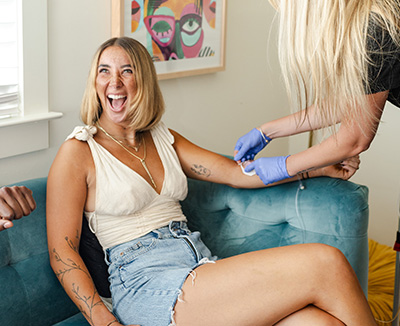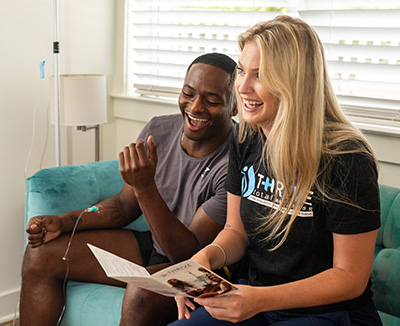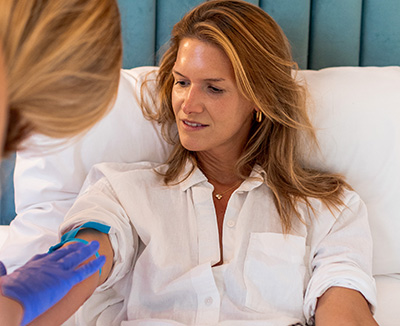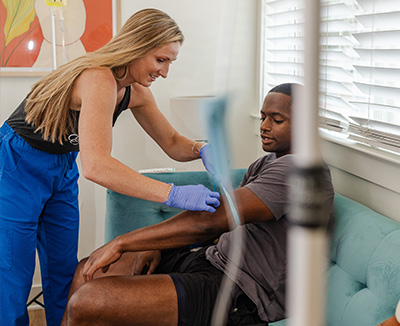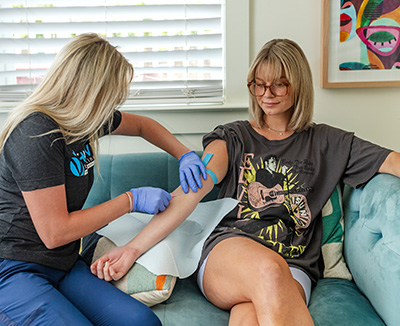Red Light Therapy – Can it help me?
At Thrive, we believe in bringing you the best wellness modalities the wellness and recovery world offers. Among these emerging trends, red light therapy stands out as one of the easiest and least talked about options, offering a non-invasive and versatile approach to wellness. Having been used since the 1960s and deeply rooted in scientific research, with a growing body of evidence supporting its efficacy, red light therapy has captured the attention of health enthusiasts worldwide. Let’s delve into what red light therapy is and explore its myriad benefits.
In short, yes, Red Light Therapy can help a plethora of physical and mental ailments from the comfort of a recliner.
Understanding Red Light Therapy:
Red light therapy, also known as low-level laser therapy (LLLT) or photobiomodulation (PBM), involves exposure to low red or near-infrared light levels. This therapy utilizes wavelengths of light that penetrate the skin to stimulate cellular activity, promoting various healing processes within the body. While the concept may seem futuristic, the principles behind red light therapy are firmly grounded in scientific inquiry and have been studied extensively for decades.
The Science Behind the Glow:
At the cellular level, red and near-infrared light interacts with mitochondria, the powerhouse of our cells, to enhance energy production. This increase in cellular energy, known as adenosine triphosphate (ATP), fuels essential biochemical reactions and supports cellular repair and regeneration. Additionally, red light therapy has been shown to reduce oxidative stress and inflammation and promote the release of nitric oxide, which improves blood flow and circulation.
Unveiling the Benefits:
- Increase Energy: By triggering an increase in the synthesis of ATP (energy) from our mitochondria (yea, the powerhouse of the cell), our cells have more capacity to do their jobs, such as reproducing, healing, and growing, more efficiently.
- Skin Rejuvenation: Red light therapy has gained widespread acclaim for its ability to promote healthy, radiant skin. Stimulating collagen production and enhancing cellular turnover can reduce the appearance of wrinkles, fine lines, and age spots. Moreover, it helps heal wounds, scars, and even acne, offering a natural and non-invasive solution for skincare concerns.
- Pain Management: For those grappling with chronic pain conditions such as arthritis, fibromyalgia, or muscle soreness, red light therapy offers a ray of hope. Targeting inflamed tissues and triggering the release of endorphins can alleviate pain and improve mobility, enhancing quality of life without the side effects associated with medications.
- Muscle Recovery: Athletes and fitness enthusiasts are turning to red light therapy to accelerate muscle recovery and enhance performance. Following intense workouts or injuries, sessions of red light therapy can reduce inflammation, mitigate muscle fatigue, and promote faster healing, allowing individuals to bounce back more robustly and resiliently.
- Mood Enhancement: Beyond its physical benefits, red light therapy also holds promise for mental well-being. SAD, or seasonal affective disorder, is caused by a lack of sunlight. Studies have shown that exposure to red light can increase serotonin levels, the neurotransmitter responsible for mood regulation, thereby alleviating symptoms of depression and anxiety. This holistic approach to mental health offers a safe and natural complement to traditional therapies.
- Hair Growth: Red light therapy presents a promising solution for those grappling with hair loss or thinning. Stimulating hair follicles and improving scalp circulation can promote hair growth and thickness, restoring confidence and vitality to individuals experiencing hair-related concerns.
- Brain Health: Near-Infrared Red (NIR) light wavelengths have been extensively researched for their ability to penetrate the skull and effectively reach the brain, offering a multitude of benefits for cognitive well-being. Scientific studies have demonstrated that NIR contributes to enhanced blood flow, increased energy levels, neuroprotective effects, inflammation reduction, and support for brain repair processes. Notably, NIR therapy has shown promise in the treatment of acute stroke, traumatic brain injuries (TBI), as well as neurodegenerative and psychiatric conditions such as dementia, Parkinson’s disease, depression, and post-traumatic stress disorder (PTSD). (Hamblin, 2016).
- Circadian Rhythm Synchronization: Some studies propose that exposure to specific wavelengths of red light in the morning may help regulate circadian rhythms and improve overall sleep quality. A study published in the Journal of Sleep Research found that participants exposed to red light in the evening experienced improvements in sleep duration and sleep efficiency compared to those exposed to blue light. Melatonin is a hormone that plays a crucial role in regulating the sleep-wake cycle. Exposure to certain wavelengths of light, especially blue light, can suppress melatonin production, potentially leading to disrupted sleep patterns. Red light, on the other hand, is thought to have a lesser impact on melatonin suppression. Studies suggest that exposure to red light may have minimal or no effect on melatonin levels, making it a potentially favorable option for light therapy in the evening. Red-light therapy has been investigated as a potential intervention for individuals with insomnia. A study published in the Journal of Affective Disorders reported that nighttime exposure to red light resulted in decreased insomnia symptoms and improved sleep quality (Figueiro & Pedler, 2020; Blume, Garbazza, & Spitschan, 2019; Figueiro, et al., 2019).
Embracing the Light:
Incorporating red light therapy into your wellness routine is simple and convenient. Thrive Total Wellness has a dedicated room with a wall panel where you can review your treatment. We start you at 5 minutes, and you can work up to longer times. For optimal benefits, individuals are advised to undergo 2-3 sessions per week, each lasting 10-15 minutes, depending on the specific condition. Whether incorporated into your skincare regimen, post-workout routine, or relaxation ritual, red light therapy offers a gentle yet potent approach to nurturing your body and mind.
As we navigate the complexities of modern living, the quest for holistic health solutions has never been more pertinent. Red light therapy emerges as a beacon of hope, harnessing the power of light to ignite healing and rejuvenation from within. With its proven benefits spanning skincare, pain management, muscle recovery, mood enhancement, and beyond, it represents a versatile tool in the pursuit of well-being. Whether seeking relief from chronic conditions, enhancing athletic performance, or simply looking to enhance your overall vitality, red light therapy offers a natural and effective pathway to optimal health. So, why not bask in the glow and embrace the transformative potential of red light therapy today?
Remember, before embarking on any new therapy or treatment regimen, it’s essential to consult with a healthcare professional to ensure it aligns with your individual needs and circumstances.
References
Blume, C., Garbazza, C., & Spitschan, M. (2019). Effects of light on human circadian rhythms, sleep and mood. Somnologie : Schlafforschung und Schlafmedizin = Somnology : sleep research and sleep medicine, 23(3), 147–156. https://doi.org/10.1007/s11818-019-00215-x
Figueiro, M. G., & Pedler, D. (2020). Red light: A novel, non-pharmacological intervention to promote alertness in shift workers. Journal of safety research, 74, 169–177. https://doi.org/10.1016/j.jsr.2020.06.003
Figueiro, M. G., Sahin, L., Roohan, C., Kalsher, M., Plitnick, B., & Rea, M. S. (2019). Effects of red light on sleep inertia. Nature and science of sleep, 11, 45–57. https://doi.org/10.2147/NSS.S195563
Hamblin M. R. (2016). Shining light on the head: Photobiomodulation for brain disorders. BBA clinical, 6, 113–124. https://doi.org/10.1016/j.bbacli.2016.09.002


